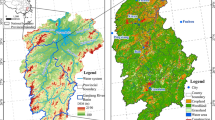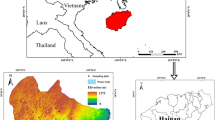Abstract
Using spatial autocorrelation methods, we explored the spatial and temporal differences in the response of soil conservation (SC) and water conservation (WC) to ecosystem fragmentation during 1990 to 2019 in Qilian Mountain National Park (QMNP) of China. We found that the degree of ecosystem fragmentation decreased over the past 30 years, improving the WC and SC capacity of the ecosystems. However, the relationship among them varied temporally and exhibited a variety of spatial patterns. The correlation between fragmentation and WC increases year by year, and the correlation with SC weakens. There is a mismatch between park-level and regional autocorrelation between fragmentation and WC and SC. The spatial relationships between fragmentation and WC and SC in the QMNP show “high-high” and “low-low” patterns in its eastern and western sections, respectively. This heterogeneity is related to the differences in ecosystem composition, especially in ecosystem WC and SC capacity, and the characteristics of ecosystem fragmentation in the east–west direction of the QMNP.






Similar content being viewed by others
Data availability
The data used in the manuscript may be available upon reasonable request.
References
Andersson, E., McPhearson, T., Kremer, P., et al. (2015). Scale and context dependence of ecosystem service providing units. Ecosystem Services, 12, 157–164.
Anselin, L. (1995). Local indicators of spatial association-LISA. Geographical Analysis, 27(2), 93–115.
Bai, Y., Ochuodho, T. O., & Yang, J. (2019). Impact of land use and climate change on water-related ecosystem services in Kentucky, USA. Ecological Indicators, 102, 51–64.
Chen, W., Liang, J., Bian, J., et al. (2022). Impact of landscape fragmentation on SC services in the Yellow River Basin. Scientia Geographica Sinica, 42(04), 589–601. (Chinese with English abstract).
Dong, X., & Liu, M. (2022). Relationships among LUCC, ecosystem services and human well-being. Journal of Beijing Normal University (Natural Science), 58, 1–11. (Chinese with English abstract).
Duan, Q., Luo, L., Zhao, W., et al. (2021). Mapping and evaluating human pressure changes in the Qilian Mountains. Remote Sensing, 13(12), 2400.
Gong, J., & Li, X. (2015). Across scales, across boundaries: A global approach to complex challenges - review of the 9th international conference on landscape ecology 2015. Acta Ecologica Sinica, 35(18), 6233–6235. (Chinese with English abstract).
Gu, X., Wei, G., & Wang, Y. (2014). Remote sensing dynamic monitoring of ecosystem service value of SC with time series data. 2014 3rd International Workshop on Earth Observation and Remote Sensing Applications (EORSA) IEEE.
Gu, Z., Zhao, X., Gao, X., et al. (2016). Change of landscape pattern and it’s evaluation of ecosystem services values in Lancang County. Ecological Science, 35(05), 143–153. (Chinese with English abstract).
Guo, J., & Shen, D. (2022). Transitions of the natural protected area system under the development of national park in China: a multiple-streams analysis. Acta Ecologica Sinica, 15, 1–9. (Chinese with English abstract).
Haaren, C. V., Lovett, A., & Albert, C. (2019). Landscape Planning with Ecosystem Services: Theories and Methods for Application in Europe. Springer.
Haines-Young, R. (2005). Landscape pattern: Context and process. In J. Wiens, & M. Moss (Eds.), Issues and Perspectives in Landscape Ecology (pp. 103–111). Cambridge University Press, New York.
Hollar, D. W. (2017). Disability and health outcomes in geospatial analyses of Southeastern US county health data. Disability and Health Journal, 10, 518–524.
Hu, W., Li, G., Gao, Z., et al. (2020). Assessment of the impact of the Poplar Ecological Retreat Project on WC in the Dongting Lake wetland region using the InVEST model. Science of the Total Environment, 733, 139423.
Huang, Q., Fan, J., & He, X. (2021). InVest-model based evaluation of WC function in Zhangjiakou Area, China. Mountain Research, 39(03), 327–337. (Chinese with English abstract).
Jiang, C., Zhang, H., Wang, X., et al. (2019). Challenging the land degradation in China’s Loess Plateau: Benefits, limitations, sustainability, and adaptive strategies of soil and water conservation. Ecological Engineering, 127, 135–150.
Li, F., Peng, D., & Wang, B. (2019). Application of research on ecosystem services in landscape planning. Landscape Architecture Frontiers, 7(4), 56–69.
Li, J., Zhou, Y., Li, Q., et al. (2022). Exploring the effects of land use changes on the landscape pattern and soil erosion of Western Hubei Province from 2000 to 2020. International Journal of Environmental Research and Public Health, 19, 1571.
Li, Z., Feng, Q., & Li, Z. (2021). Reversing conflict between humans and the environment-The experience in the Qilian Mountains. Renewable and Sustainable Energy Reviews, 148.
Liu, D., Du, S., & Wang, C. (2021a). Landscape pattern change and its response to ecosystem services value in a rural tourism area—A case study at Taihu National Tourism Resort in Wuxi City of Jiangsu Province. Bulletin of Soil and Water Conservation, 41(05), 264–275. (Chinese with English abstract).
Liu, J., Lang, X., Su, J., et al. (2021b). Evaluation of WC function in the dry-hot valley area of Jinsha River Basin based on InVEST model. Acta Ecologica Sinica, 41(20), 8099–8111. (Chinese with English abstract).
Liu, J., Liu, X., & Hou, L. (2012). Changes and ecological vulnerability of landscape pattern in Eastern Qilian Mountain. Arid Land Geography, 35(05), 795–805. (Chinese with English abstract).
Liu, L., Ding, S., Ren, J., et al. (2019). Effects of landscape spatial heterogeneity on surface water quality service: A case study in Yihe River basin, Henan province. Geographical Research, 38(06), 1527–1541. (Chinese with English abstract).
Liu, Y., Wang, S., Chen, Z., et al. (2022). Research on the response of ecosystem service function to landscape pattern changes caused by land use transition: A case study of the Guangxi Zhuang Autonomous Region. China Land, 11(5), 752.
Lü, Y., Fu, B., Feng, X., et al. (2012). A policy driven large scale ecological restoration: Quantifying ecosystem services changes in the Loess Plateau of China. PLoS ONE, 7(2), e31782.
Ouyang, Z., Zhang, L., Wu, B., et al. (2015). An ecosystem classification system based on remote sensor information in China. Acta Ecologica Sinica, 35(2), 219–226. (Chinese with English abstract).
Ren, B., Park, K., Shrestha, A., et al. (2022). Impact of human disturbances on the spatial heterogeneity of landscape fragmentation in Qilian Mountain National Park. China Land, 11, 2087.
Shao, D., & Wu, D. (2020). Analysis on the effect of landscape fragmentation on ecosystem service value: A case study of Suzhou. Resources and Environment in the Yangtze Basin, 29(11), 2436–2449. (Chinese with English abstract).
Smiraglia, D., Tombolini, I., Canfora, L., et al. (2019). The latent relationship between soil vulnerability to degradation and land fragmentation: A statistical analysis of landscape metrics in Italy, 1960–2010. Environmental Management, 64(2), 154–165.
Su, S., Xiao, R., & Jiang, Z. (2012). Characterizing landscape pattern and ecosystem service value changes for urbanization impacts at an eco-regional scale. Applied Geography, 34, 295–305.
Sun, C., Wu, Z., Lu, Z., et al. (2013). Quantifying different types of urban growth and the change dynamic in Guangzhou using multi-temporal remote sensing date. International Journal of Applied Earth Observation and Geoinformation, 21(1), 409–417.
Verhagen, W., Van Teeffelen, A., Compagnucci, A., et al. (2016). Effects of landscape configuration on mapping ecosystem service capacity: A review of evidence and a case study in Scotland. Landscape Ecology, 31(7), 1457–1479.
Wang, Y., Ding, J., Li, X., et al. (2022b). Impact of LUCC on ecosystem services values in the Yili River Basin based on an intensity analysis model. Acta Ecologica Sinica, 42(08), 3106–3118. (Chinese with English abstract).
Wang, J., & Gong, B. (2019). Evolution of landscape pattern and ecological risk in Xixian new area. Journal of Northwest Forestry University, 34(02), 250–256. (Chinese with English abstract).
Wang, R., Peng, Q., Zhang, W., et al. (2022a). Ecohydrological service characteristics of Qilian Mountain Ecosystem in the next 30 years based on scenario simulation. Sustainability, 14(3), 1819.
Wang, H., Qin, F., Zhu, J., et al. (2017). The effects of land use structure and landscape pattern change on ecosystem service values. Acta Ecologica Sinica, 37(04), 1286–1296. (Chinese with English abstract).
Wang, Y., Yang, H., Qi, D., et al. (2021). Efficacy and management challenges of the zoning designations of China’s national parks. Biological Conservation, 254.
Xu, H., Zhao, C., Chen, S., et al. (2022a). Spatial relationships among regulating ecosystem services in mountainous regions: Nonlinear and elevation-dependent. Journal of Cleaner Production, 380.
Xu, H., Zhao, C., Wang, X., et al. (2022b). Spatial differentiation of determinants for WC dynamics in a dryland mountain. Journal of Cleaner Production, 362.
Xu, W., Pimm, S. L., Du, A., et al. (2019a). Transforming protected area management in China. Trends in Ecology and Evolution, 34(9), 762–766.
Xu, Y., Liu, X., Li, X., et al. (2019b). Response of ecological sensitivity to landscape dynamic change in the eastern section of Qilian Mountain. Ecological Science, 38(5), 160–167.
Xu, Y., Tang, H., Wang, B., et al. (2017). Effects of landscape patterns on soil erosion processes in a mountain–basin system in the North China. Natural Hazards, 87(3), 1567–1585.
You, C., Zhou, Y., & Yu, L. (2006). An introduction of quantitative methods in landscape pattern fragmentation. Chinese Agricultural Science Bulletin, 05, 146–151. (Chinese with English abstract).
Yun, J., Liu, H., Xu, Z., et al. (2022). Assessing changes in the landscape pattern of wetlands and its impact on the value of wetland ecosystem services in the Yellow River Basin. Inner Mongolia. Sustainability, 14(10), 6328.
Zhang, H., Jin, Y., Dou, H., et al. (2021). Study on the changes of land use and landscape pattern in Heilongjiang Laoyeling Amur Tiger National Nature Reserve. Chinese Journal of Wildlife, 42(02), 479–486. (Chinese with English abstract).
Zhang, M., Wang, K., Liu, H., et al. (2011). Responses of spatial-temporal variation of Karst ecosystem service values to landscape pattern in northwest of Guangxi. Chinese Geographical Science, 21, 446.
Zheng, B., Huang, Q., Tao, L., et al. (2021). Landscape pattern change and its impacts on the ecosystem services value in southern Jiangxi Province. Acta Ecologica Sinica, 41(15), 5940–5949. (Chinese with English abstract).
Zhou, S., Liu, S., & Peng, L. (2021). Correlation effect in the developing of landscape patterns with the changes in ecosystem services in Chengdu City, China. Mountain Research, 39(02), 262–274. (Chinese with English abstract).
Zoppi, C., Argiolas, M., & Lai, S. (2015). Factors influencing the value of houses: Estimates for the city of Cagliari, Italy. Land Use Policy, 42, 367–380.
Zou, L., Wang, J., & Bai, M. (2022). Assessing spatial-temporal heterogeneity of China’s landscape fragmentation in 1980–2020. Ecological Indicators, 136.
Zuo, D., Luo, P., Yang, H., et al. (2019). Assessing the space neighborhood effects and the protection effectiveness of a protected area-a case study from Zoige Wetland National Nature Reserve. Chinese Journal of Applied and Environmental Biology, 25(04), 854–861. (Chinese with English abstract).
Funding
This work was financially supported by the National Key Research and Development Program of China (Grant No. 2019YFC0507402).
Author information
Authors and Affiliations
Contributions
Conceptualization, X.G.; methodology, X.G., R.W. (Ruiyang Wen) and S.C. (Shuhang Chang); formal analysis, X.G., R.W., J.L., and A.Y.; writing—original draft preparation, X.G., R.W., J.L. and A.Y.; writing—review and editing, X.G., R.W., S.C., J.L., and A.Y.; supervision, X.G.; funding acquisition, X.G.
Corresponding author
Ethics declarations
All authors have read, understood, and have complied as applicable with the statement on “Ethical responsibilities of Authors” as found in the Instructions for Authors and are aware that with minor exceptions, no changes can be made to authorship once the paper is submitted.
Competing interests
The authors declare no competing interests.
Additional information
Publisher's Note
Springer Nature remains neutral with regard to jurisdictional claims in published maps and institutional affiliations.
Rights and permissions
Springer Nature or its licensor (e.g. a society or other partner) holds exclusive rights to this article under a publishing agreement with the author(s) or other rightsholder(s); author self-archiving of the accepted manuscript version of this article is solely governed by the terms of such publishing agreement and applicable law.
About this article
Cite this article
Gao, X., Wen, R., Chang, S. et al. Spatial and temporal differences in the response of water conservation and soil conservation to ecosystem fragmentation: evidence from Qilian Mountain National Park of China. Environ Monit Assess 195, 904 (2023). https://doi.org/10.1007/s10661-023-11538-6
Received:
Accepted:
Published:
DOI: https://doi.org/10.1007/s10661-023-11538-6




